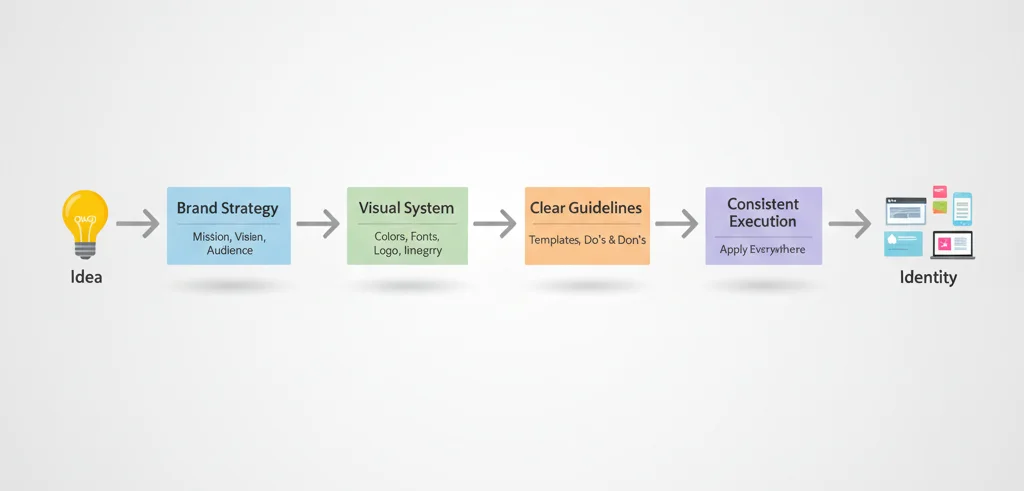How creators and startups can build consistent, professional brands without hiring a full design team.

Let's address the elephant in the room that's haunting every startup founder: "I can't afford a design team, so my brand will never look professional."
That's not just wrong — it's the exact opposite of the truth.
You don't need five designers, a brand strategist, and a six-figure budget to build a brand that looks and feels professional. What you need is something far more valuable and far less expensive: a clear system.
And here's the reality that might surprise you: some of the most iconic brands in startup history were built with minimal design resources but maximum strategic clarity.
The Myth of the Design Team
Let's bust this myth wide open. The startup world has perpetuated a dangerous belief: professional branding requires professional designers on staff.
Here's what actually happens when early-stage startups try to hire their way to brand consistency:
Scenario 1: The Freelance Carousel You hire a freelancer for your logo. Then another for your website. Another for social media graphics. A fourth for your pitch deck. Each one interprets your vision differently. The result? A Frankenstein brand that looks like four different companies stitched together.
Scenario 2: The Expensive Agency You scrape together $30K-$50K to hire a brand agency. They deliver a beautiful brand book. Then they leave. Three months later, your team is making it up as they go because no one really understood the system or knows how to apply it to new situations.
Scenario 3: The In-House Hire You hire a designer. Great! But they're now responsible for everything — from Instagram posts to website updates to investor presentations. They become a bottleneck. Every visual decision flows through one overwhelmed person, and speed dies.
The problem in all three scenarios isn't the designers. The problem is that branding was treated as a design problem instead of a systems problem.
What Startups Actually Need
Here's the truth that changes everything: Branding is 80% system and 20% execution.
The startups that build strong, consistent brands early don't necessarily have better designers. They have better systems. They know:
- What they stand for (brand strategy)
- Who they're talking to (audience clarity)
- How they want to sound (voice and messaging)
- What visual elements represent them (design system)
- How to apply these consistently (clear guidelines)
Once you have this system defined, the actual design execution becomes almost mechanical. It's not about creative genius — it's about following a playbook.
And here's the beautiful part: you can build this system yourself, or with minimal help, and then use it to create consistent branding without a full-time designer.

The System That Replaces the Design Team
Let's break down what this system actually looks like in practice:
Step 1: Strategic Clarity (The Foundation)
Before you think about fonts or colors, get crystal clear on:
Your brand positioning: What makes you different? Why do you exist? What problem are you solving in a way no one else is?
Your audience: Who are you serving? What do they care about? How do they make decisions?
Your brand personality: If your brand were a person at a party, who would they be? Approachable and funny? Sophisticated and refined? Bold and disruptive?
Your core message: What's the one thing you want people to remember about you?
You don't need a designer for this. You need thinking time, customer conversations, and honest self-reflection.
Step 2: Visual System Creation (The Framework)
This is where you make strategic visual decisions and document them:
Color palette: Choose 2-3 primary colors and 2-3 accent colors. Document the exact codes (hex, RGB, CMYK). Define when to use each.
Typography: Select 2-3 fonts maximum (one for headlines, one for body text, maybe one for special uses). Define the hierarchy.
Logo and lockups: You might need a designer for an hour or two here, or you might use a logo creation tool. Either way, document every variation (full logo, icon only, black and white version) and usage rules.
Photography/imagery style: Define what kind of images represent your brand. This doesn't require a designer — it requires decision-making. Modern or vintage? Bold or minimal? Candid or staged?
Graphic elements: Any patterns, shapes, or visual elements that are uniquely yours.
Here's the key: you're not trying to be the designer. You're being the art director. You're making strategic decisions and documenting them. The actual creation of final assets can happen later, by anyone, using your system.
Step 3: Template Creation (The Accelerator)
Now you create templates for everything you'll need regularly:
- Social media post templates
- Presentation slide templates
- Email signature template
- One-page document template
- Website component templates
Tools like Canva, Figma (free tier), or even PowerPoint can do this. You set up these templates once, following your system. From that point forward, anyone on your team can create on-brand materials in minutes, not hours.
This is where the magic happens: your system becomes self-service. Instead of needing a designer for every Instagram post or pitch deck update, your team just opens the template and fills in the content.
Step 4: Documentation (The Multiplier)
Create a simple brand book — 10 to 20 pages — that documents all of the above. Include:
- Visual examples of everything
- Clear do's and don'ts
- Access to templates
- Quick reference guides
This document is your brand's operating manual. When you hire a freelancer, onboard a team member, or work with a partner, you hand them this document. Boom — they're aligned.
The ROI of Systems Over Teams
Let's talk numbers for a moment, because this is where the system approach really shines:
Traditional approach:
- Brand agency: $30,000-$80,000
- Or: Full-time designer: $60,000-$90,000/year
- Or: Freelancers per project: $500-$5,000 each × multiple projects
System approach:
- Initial system setup (you + maybe 10 hours of pro help): $2,000-$5,000
- Template creation: 20-30 hours of your time
- Ongoing execution: handled by your team using templates
The savings are massive. But more importantly, you maintain control and speed.
With a system, you can:
- Launch a new campaign in hours, not weeks
- Onboard new team members instantly
- Create content without waiting for designer availability
- Scale your brand across channels without scaling your team
- Pivot quickly when needed without starting over
Real-World Examples
Think about companies like Stripe, Notion, or Linear. Their brands feel incredibly cohesive and professional. Were they built by huge design teams in the early days? No.
They were built by founders who understood that branding is a system. They made clear strategic decisions, documented them, and applied them consistently. As they grew, they could hire designers to elevate the execution — but the system was there from day one.
Compare that to startups that hire designer after designer, trying to "fix" their brand. They waste time, money, and momentum because they never built the underlying system.
When to Bring In Designers
Here's the nuanced truth: you don't need a team of designers, but strategic design help at the right moments is valuable.
Bring in professional design help for:
The kickstart: 5-10 hours with a good brand designer to help you create your initial logo and core visual elements based on your strategic decisions.
The refinement: Once your business has traction, invest in refining your system. A designer can elevate your templates, improve your visual hierarchy, and add polish.
The specialties: When you need something outside your core system (product design, complex animations, custom illustrations), hire specialists for those specific projects.
But the difference is: they're working within your system, not creating the system. You're the architect; they're executing specific rooms in the house you've designed.
How to Get Started Today
If you're reading this and thinking, "Okay, I'm convinced, but where do I actually start?" — here's your action plan:
Week 1: Strategic Clarity
- Write down your mission, values, and unique positioning
- Define your target audience in detail
- Identify 3-5 brand personality traits
- Craft your core message
Week 2: Visual Decisions
- Choose your color palette (tools like Coolors or Adobe Color can help)
- Select your fonts (Google Fonts is free and professional)
- Define your imagery style (collect 10-15 reference images that feel like your brand)
Week 3: Creation and Documentation
- Create or commission your logo
- Design 3-5 core templates (social media, presentation, document)
- Document everything in a simple brand book
Week 4: Implementation
- Share your brand book with your team
- Create your first batch of materials using the system
- Refine based on what works
That's it. One month. Minimal cost. Maximum impact.
The Competitive Advantage of Systems
Here's what most startups miss: in 2025, having a professional-looking brand isn't a competitive advantage — it's table stakes.
Customers expect consistency. Investors expect polish. Partners expect professionalism.
But hiring your way there is slow and expensive. Building a system is fast and scalable.
The startups that win aren't the ones with the biggest design budgets. They're the ones with the clearest systems. They can move faster, maintain consistency across channels, and scale their brand without scaling their costs.
The Bottom Line
You don't need a team of designers camped out in your office. You don't need a $50,000 agency retainer. You don't need to wait until you're "big enough" to have a real brand.
You need clarity about who you are. You need a documented system. You need templates that empower your team. And you need the confidence to build it yourself (with strategic help where it matters).
Great branding isn't about having more resources — it's about having more clarity.
Start with the system. The beautiful execution will follow. And you'll build a brand that's not just consistent and professional, but truly yours — created with intention, built to scale, and designed to grow with you.
Ready to build your brand system? Start with strategy, not designers. Define your system, document it clearly, and watch your brand come to life — without the team of designers you thought you needed.